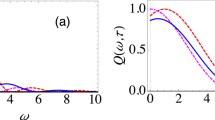Abstract
In theory, the decay of any unstable quantum state can be inhibited by sufficiently frequent measurements—the quantum Zeno effect1,2,3,4,5,6,7,8,9,10. Although this prediction has been tested only for transitions between two coupled, essentially stable states5,6,7,8, the quantum Zeno effect is thought to be a general feature of quantum mechanics, applicable to radioactive3 or radiative decay processes6,9. This generality arises from the assumption that, in principle, successive observations can be made at time intervals too short for the system to change appreciably1,2,3,4. Here we show not only that the quantum Zeno effect is fundamentally unattainable in radiative or radioactive decay (because the required measurement rates would cause the system to disintegrate), but also that these processes may be accelerated by frequent measurements. We find that the modification of the decay process is determined by the energy spread incurred by the measurements (as a result of the time–energy uncertainty relation), and the distribution of states to which the decaying state is coupled. Whereas the inhibitory quantum Zeno effect may be feasible in a limited class of systems, the opposite effect—accelerated decay—appears to be much more ubiquitous.


Similar content being viewed by others
References
Khalfin, L. S. Phenomenological theory of K0 mesons and the non-exponential character of the decay. JETP Lett. 8, 65 –68 (1968).
Misra, B. & Sudarshan, E. C. G. The Zeno's paradox in quantum theory. J. Math. Phys. 18, 756– 763 (1977).
Sakurai, J. J. Modern Quantum Mechanics 484–486 (Addison-Wesley, Reading, Massachusetts, 1994).
Joos, E. Continuous measurement: Watchdog effect versus golden rule. Phys. Rev. A 29, 1626–1633 (1984).
Cook, R. J. What are quantum jumps? Phys. Scr. T 21, 49–51 (1988).
Itano, W. M., Heinzen, D. J., Bollinger, J. J. & Wineland, D. J. Quantum Zeno effect. Phys. Rev. A 41, 2295 –2300 (1990).
Knight, P. L. Watching a laser hot-pot. Nature 344, 493 –494 (1990).
Frerichs, V. & Schenzle, A. Quantum Zeno effect without collapse of wave packet. Phys. Rev. A 44, 1962– 1968 (1991).
Schulman, L. S. Continuous and pulsed observations in the quantum Zeno effect. Phys. Rev. A 57, 1509–1515 (1998).
Facchi, P. & Pascazio, S. Temporal behavior and quantum Zeno time of an excited state of the hydrogen atom. Phys. Lett. A 241, 139–144 (1998).
Fearn, H. & Lamb, W. E. Jr Computational approach to the quantum Zeno effect: Position measurements. Phys. Rev. A 46, 1199–1205 ( 1992).
Kofman, A. G. & Kurizki, G. Quantum Zeno effect on atomic excitation decay in resonators. Phys. Rev. A 54, R3750 –R3753 (1996).
Cohen-Tannoudji, C., Dupont-Roc, J. & Grynberg, G. Atom-Photon Interactions (Wiley, New York, 1992).
Milburn, G. J. Quantum Zeno effect and motional narrowing in a two-level system. J. Opt. Soc. Am. B 5, 1317–1322 (1988).
Moses, H. E. Exact electromagnetic matrix elements and exact selection rules for hydrogenic atoms. Lett. Nuovo Cimento. 4, 51– 53 (1972).
Beige, A. & Hegerfeldt, G. C. Quantum Zeno effect and light-dark periods for a single atom. J. Phys. A 40, 1323–1334 (1997).
Harel, G., Kofman, A. G., Kozhekin, A. & Kurizki, G. Control of non-Markovian decay and decoherence by measurements and interference. Opt. Express 2, 355–367 (1998).
Acknowledgements
G.K. is the G. Dunne Professor of Chemical Physics, A.K. is supported by the Israel Ministry of Absorption. This work was supported by the ISF, Minerva and EU (TMR).
Author information
Authors and Affiliations
Corresponding author
Rights and permissions
About this article
Cite this article
Kofman, A., Kurizki, G. Acceleration of quantum decay processes by frequent observations. Nature 405, 546–550 (2000). https://doi.org/10.1038/35014537
Received:
Accepted:
Issue Date:
DOI: https://doi.org/10.1038/35014537
- Springer Nature Limited
This article is cited by
-
Probing many-body dynamics in a two-dimensional dipolar spin ensemble
Nature Physics (2023)
-
A giant atom with modulated transition frequency
Frontiers of Physics (2023)
-
One-component quantum mechanics and dynamical leakage-free paths
Scientific Reports (2022)
-
Quantum Zeno repeaters
Scientific Reports (2022)
-
Engineered dissipation for quantum information science
Nature Reviews Physics (2022)





